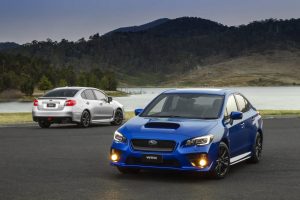Recalls: Subaru V1 WRX
Overview
Manufacturers, or importers, issue recalls for defects or faults which have the potential to cause injury. Generally, manufacturers will inform the original buyers if their vehicle is subject to a recall and of the steps required to remedy the defect or fault. Please note that the recalls below (if any) are for Australian-delivered vehicles only. Furthermore, the number of recalls should not be taken as an indication of a model’s reliability or its safety more generally.
Recalls: Subaru V1 WRX
2015-16 model year Subaru V1 WRX: cracks in air intake duct
In March 2016, a recall was issued for 2015 and 2016 ‘model year’ Subaru WRX vehicles because the air intake ducts may develop cracks. The cracks may cause rough engine idle, lower engine power and, at worst, engine stalling which could pose a potential hazard to the driver and other road users (PRA 2016/15275).
2015 model year Subaru WRX and WRX STi: Harman Kardon subwoofer
In October 2017, a recall was issued for 2015 model year Subaru WRX and WRX STi vehicles that were equipped with a Harman Kardon subwoofer. If cargo contacted the underside of the subwoofer that protruded into the boot area, it could cause an electrical short circuit such that the subwoofer could overheat – this also posed a fire hazard. For the VINs of the recalled Subaru WRX and WRX STI vehicles, please see PRA 2017/16364.
2018-19 Subaru V1 WRX: deformed fuel pump impeller and loss of power
In August 2021, recall campaign SRT-311 was issued for 2018-19 Subaru V1 WRX vehicles. The fuel pump impeller may not meet manufacturing specifications and could therefore deform. If this occurred, the fuel pump may stop working and the engine may stall, causing a loss of power; this condition increased the risk of a collision and injury to vehicle occupants and other road users.
For the VINs of the recalled vehicles, please see REC-001697.
2015-18 Subaru V1 WRX: vehicle could roll away while in ‘park’
In August 2022, recall campaign SRT324 was issued for 2015-18 Subaru V1 WRX vehicles. Due to a manufacturing defect, the Electronic Park Brake (EPB) adaptor cord connector may not operate as intended. This condition could result in the vehicle moving or rolling away whilst the ‘park’ was selected, increasing the risk of a collision and injury to vehicle occupants and other road users. For the VINs of the recalled vehicles, please see REC-005485.
2015-21 Subaru V1 WRX STi: reverse lamps and rear-view camera may not work
In August 2022, recall campaign SRT323 was issued for 2015-21 Subaru V1 WRX STi vehicles. In these vehicles, the reverse lamps may not illuminate and the rear-view reverse camera may not display the rearwards image when reversing. If these ocurred, the risk of a collision and injury to vehicle occupants and other road users would be increased. For the VINs of the recalled vehicles, please see REC-005484.
Problems and faults: Subaru V1 WRX
Overview
This section identifies potential problems, causes and fixes based on the experiences of owners and repairers, online sources and technical service bulletins. This information is provided solely for reference purposes and AustralianCar.Reviews recommends that only properly qualified persons carry out repairs or modifications. Furthermore, the number of items below should not be taken as an indicator of a model’s reliability or the frequency with which they may occur.
To report a problem or fault to the AustralianCar.Reviews team, please use the Contact Us form. Note that AustralianCar.Reviews does not offer advice on automotive problems or disputes; such enquiries will not receive a reply. For vehicles purchased from dealers after 1 January 2011, please see our Australian Consumer Law fact sheet.
2014 Subaru V1 WRX: rough idle and misfires (pre-ignition)
In February 2016, Subaru issued Service Bulletin WQW-58R for Subaru V1 WRX vehicles that were produced from 17 January 2014 to 26 September 2014. According to the bulletin, these vehicles may exhibit:
- Engine idle roughness;
- Engine noise; and/or
- Damage resulting from spark knock (pre-ignition).
The service bulletin described that these concerns were to be addressed by re-programming the Engine Control Module (ECM). Specifically, the logic for the ECM:
- Changed Fuel Cut control when the fuel level was near empty;
- Improved idle smoothness/quality; and,
- Changed boost pressure control under wide-open throttle (WOT) conditions. The bulletin identified that high engine load driving conditions (such as WOT) could cause pre-ignition, resulting in elevated cylinder temperatures and pressures. Over time, this could cause excessive erosion of the spark plugs and damage to the pistons.
2014-15 Subaru WRX: rough idle on restart and DTC P0300
In February 2016, Subaru issued Service Bulletin 11-161-16 for Subaru V1 WRX vehicles that had VINs preceding F*818365. When restarting the engine while it was still warm, these vehicles may exhibit a rough idle and, in rare cases, Diagnostic Trouble Code (DTC) P0300 may be stored in the Engine Control Module (ECM). To fix, the ECM was to be re-programmed.
2015-17 model year Subaru V1 WRX CVT: seeping transmission fluid
In January 2019, Subaru issued Technical Service Bulletin 16-103-16R for 2015-17 model year Subaru V1 WRX vehicles that had TR690 continuously variable transmissions (Subaru’s ‘Lineartronic’ CVT). According to the bulletin, gasket material sealing failure could cause continuously variable transmission fluid (CVTF) to seep from the CVT’s oil pump chain cover. To fix, the cover was to be removed, cleaned, the sealing surfaces inspected, and then the cover was to be re-sealed.
Subaru V1 WRX: ‘Lineartronic’ CVT slow to engage drive/reverse
Subaru’s ‘Lineartronic’ continuously variable transmissions (CVTs) are slower to shift to/from reverse or drive than conventional automatic transmissions – this occurs because significant pressure must be generated before the sheaves (i.e. the sides of the pulley that contact the metal belt) can clamp the belt such that it will not slip. According to Subaru service manuals, the normal delay or lag when switching into reverse or drive from park is 1.5 seconds or less.
Some Subaru owners, however, have reported delays of around three (3) or four (4) seconds when switching between reverse and drive. While re-flashing the transmission control module (TCM) and replacing the CVT fluid have reduced the delay to within Subaru’s normal range, the delay has subsequently increased over time.
2014-15 Subaru V1 WRX CVT: extended warranty in USA
In March 2018, Subaru of America issued service bulletin 16-107-17R which extended the powertrain warranty for the continuously variable transmissions (Subaru’s ‘Lineartronic’ CVT) in 2014-15 Subaru V1 WRX CVT vehicles from five years or 60,000 miles (whichever came first) to ten years and 100,000 miles (whichever came first).
Subaru of America claimed that the change was not in response to any specific condition, but ‘to provide customers with added reassurance regarding the function and overall performance of their CVT’. After expiration of the original warranty period, however, owners have reported that the transmission may shudders (or shake), particularly when slowing down. Other symptoms include hesitations and occasional stalling.
2014-16 Subaru WRX and WRX STi: creaking sound when using clutch pedal
In January 2017, Subaru issued Service Bulletin 12-215-17 for 2014-16 Subaru V1 WRX and WRX STi vehicles which had manual transmissions and VINs preceding G*830278. For these vehicles, a more rigid brake/clutch pedal bracket assembly was developed to prevent a creaking noise that could occur when the clutch pedal was operated. Specifically, the revised pedal bracket design incorporated an extended flange length and additional welding. The creaking noise of the original assembly, however, did not indicate an ‘operational issue with pedal assembly, clutch hydraulic system, clutch assembly or, serve as a precursor to any future concerns.’




